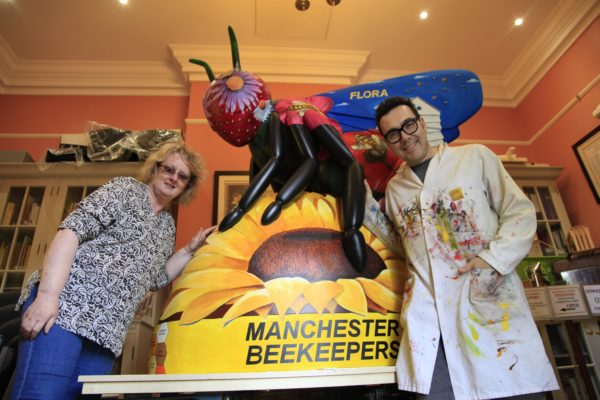
Lena Crowe, President of the Manchester & District Beekeepers’ Association, tells us all about beekeeping for Environment and Bee Conservation week.
Tell us a little about the Manchester & District Beekeepers’ Association
The Manchester & District Beekeepers’ Association has been promoting the art of beekeeping since 1895. We’re based at the Dower House in Heaton Park, where we have an apiary, a shop and an observation hive where you can watch the bees going about their business. We train many beekeepers from all over the UK and run beginners’ courses for members of the public.
How did you get started with beekeeping?
People become beekeepers for a whole variety of reasons, be it environmental, a love of flora and fauna, or indeed because they love honey! I was in my late 40s and needed an escape from the day to day stresses of work and family commitments – something for me to indulge in, a distraction, a hobby.
I have always had an interest in bugs and beasties since I was a young child, going on many a walk with my Grandad. In 2005 I visited the Manchester & District Beekeepers’ Association at the Dower House in Heaton Park. My husband David and I then did a winter theory course, and in the summer of 2006 we got our first colony of honey bees. I was well and truly hooked! I soon became very involved as a volunteer and have been ever since.
How many bees do you look after in the apiary?
David and I have four colonies of our own on our allotment, but the Manchester & District Beekeepers’ Association have many more! We have around 30 colonies (which is over 1 million individual bees) in our teaching apiary.
How many bees live in a beehive?
In the height of the summer season you could expect to have 1 queen, approximately 40,000 workers and around 2,000 drones in a colony. These figures change dramatically in the winter months to 1 queen, approximately 10,000 workers and no drones.
The queen is the only fertile female in the colony and is the mother of all the other bees. The workers are all infertile females, and they do all of the work both inside and outside of the hive. The drones are the males and their only purpose is to mate with young virgin queens – they die very soon after which is a bit grizzly!
How is honey made, and how do you extract it from the beehives?
The worker bees go out on foraging flights to collect nectar and pollen from plants. It’s the nectar which the bees turn into honey.
Bees have two stomachs – one for storing honey, and one for their own food. They collect nectar from the plant and store it in their honey crop stomach. They then take the nectar back to the hive and store it in the small cells of the beehive frame. When the water content is lower than 18% the workers will seal the honey in with a wax capping.
When we beekeepers extract the honey, we first remove the wax capping very carefully. Then we put the frame into a centrifugal extractor and the honey just flows out of the cells. Finally, the honey is put into jars and sold – and most importantly, eaten!
Why is it so important to look after our bee population?
It’s very important that we all do what we can to look after all pollinating insects, including honey bees. Without these insects almost the whole food chain would be lost! It sounds dramatic to say, but they play a very important part in life as we know it.
How can we encourage bees in to our own gardens?
We can all do our bit to encourage bees and other insects into our gardens. You could have an untidy area in your garden and plant nectar and pollen producing plants there to encourage insects. You could also put up a wild or solitary insect house or make your own from bamboo sticks.
If you’re really keen you can do a beekeeping course and learn how to keep bees yourself!
You can find the Manchester & District Beekeepers’ Association’s Bees, Flora and Fauna, in Heaton Park. (Flora is outside the Dower House and her little sister Fauna is in the Stables Café).





